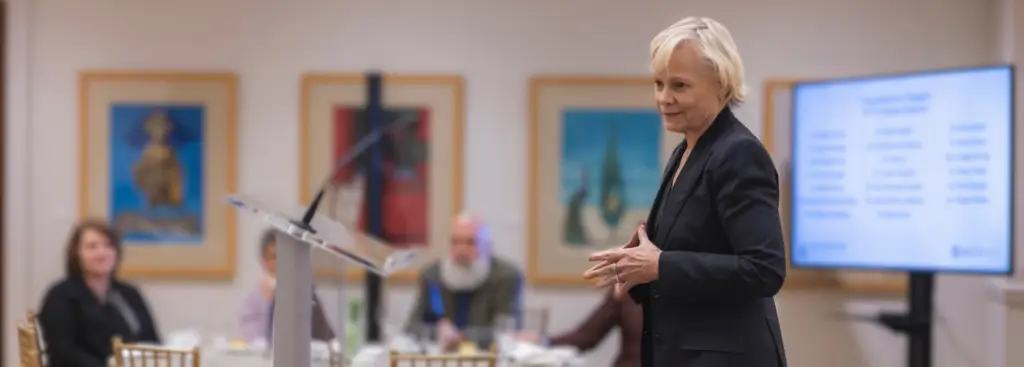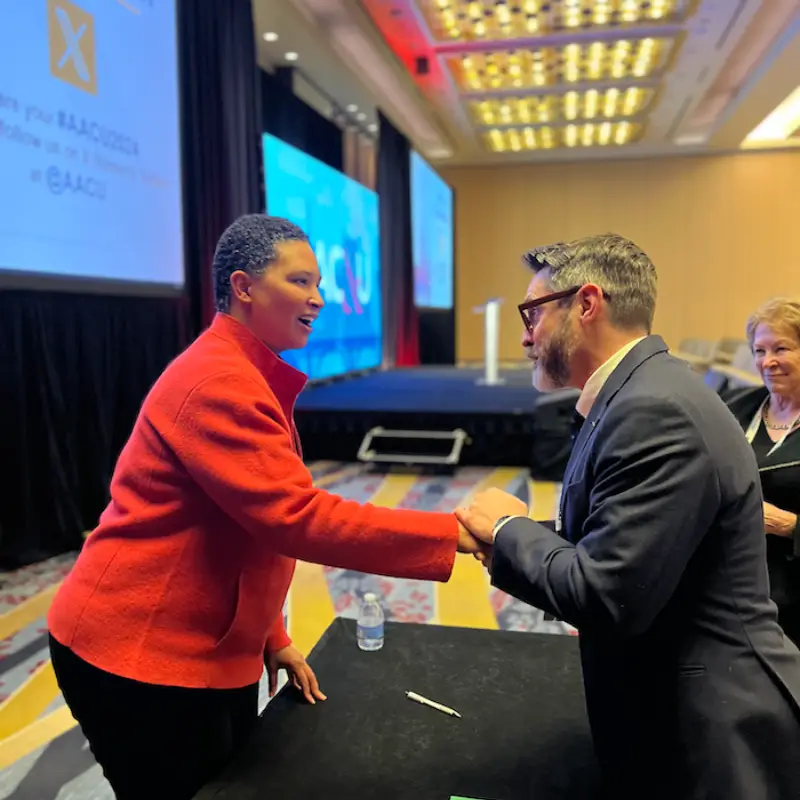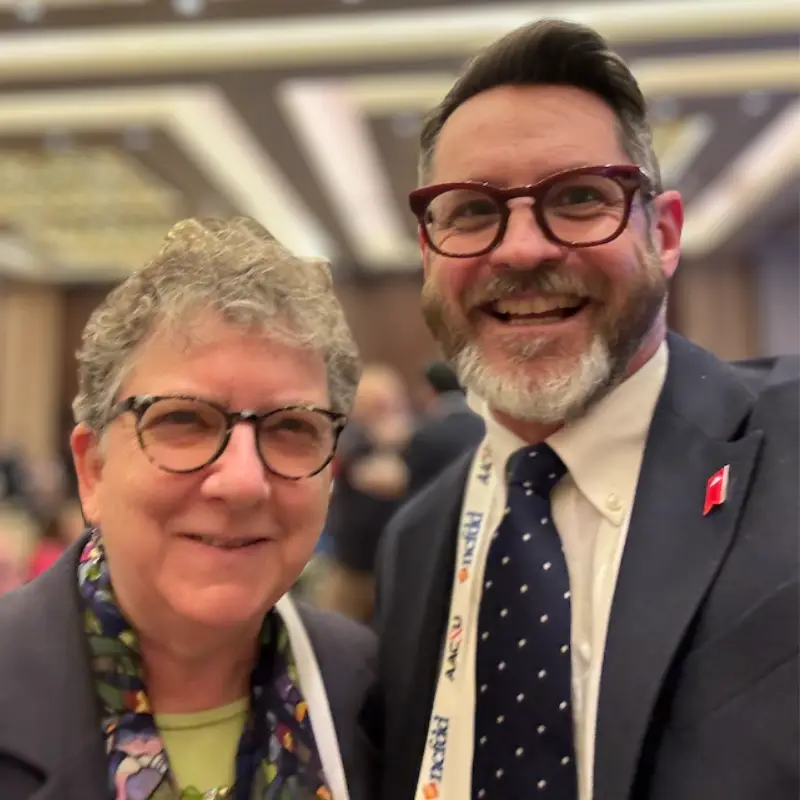



At ACUE, we recognize the transformative potential of generative AI in higher education. What’s paramount, however, is understanding how to bring it to your faculty, students, and institution responsibly.
Many campus leaders and faculty share that sentiment as evidenced by the enthusiastic reception of our AI Quick Study courses and the lively discussions during our recent webinar, “Getting Started With an AI Policy for Your Campus,” led by Dr. Penny MacCormack, ACUE’s chief academic officer.
To continue the conversation, we’re spotlighting a strategy guide we just came across from MIT SMR Connections, a subsection within MIT Sloan Management Review. It focuses on responsibly using generative AI in higher ed, and we think it nicely complements our recent webinar by showcasing successful practices from various institutions and highlighting the need to prepare staff and faculty for an AI-driven world with training and support. Here are some key points that MIT’s guide delves into:

Learn how institutions are creating policies to ensure the responsible use of AI by focusing on fairness, accuracy, and privacy.
Understand the importance of AI literacy and the steps universities are taking to educate their communities about AI.
Explore the benefits of AI in improving student engagement, personalizing learning, and supporting instructors in their educational tasks.
Discover strategies to mitigate the risks of AI-generated misinformation and ensure the reliability of AI tools.
Find out how institutions are securing AI tools and making them accessible to all students, including those with disabilities.
See how universities are preparing students for a future where AI plays a crucial role, both during their studies and in their careers.
We’d love to hear your thoughts on this guide and other AI resources that you’ve found to be insightful. As AI and emerging trends and topics continue to evolve, you can count on ACUE to be there to support you, your faculty, and your institution with evidence-based teaching practices you can trust.

Connect with us to learn how to bring the trusted ACUE Learning Lab of Quick Study courses to your institution. These flexible, self-paced learning experiences can have your faculty confident and ready to implement teaching practices in as little as 1 hour.

Connect with us to learn how to bring the trusted ACUE Learning Lab of Quick Study courses to your institution. These flexible, self-paced learning experiences can have your faculty confident and ready to implement teaching practices in as little as 1 hour.

President, Net Edge Training, LLC
I am sitting in a large meeting space at a university in Texas with tables spread across the room. Each table has six to eight students and they are tackling the hot topic of gun control. This could end up being one of the most contentious conversations I have witnessed. But because the faculty facilitator is employing a well-constructed and intentional approach to a deliberative dialogue the students are having thoughtful and constructive conversation that is informed by fact and reason, acknowledges cognitive bias, and is respectful of the multiple perspectives and views in the room.
It can seem nearly impossible to surmount the biases that are so ingrained in each of us and to rise above our partisan and polarized landscape. But by utilizing Constructive Conversations, we found that students were more engaged, strengthened their critical thinking skills, and built connections across ideological divides.
Constructive conversations connect academic rigor with credible sources of information, utilizing an intentional process for dialogue in a way that is approachable to students and yields significant results. It is a creative and hands-on experience that is suited to any discipline.
So, how in the world did these students accomplish this level of discourse?
There were guidelines and processes in place that made this and other constructive conversations possible.
By creating a culture of exploration and inquiry, we can equip and inspire students with the knowledge, skills, and experiences to tackle society’s most pressing problems. A culture that engages students, promotes critical thinking, and supports their ability to take in the complexity of multiple perspectives, political ideologies, and lived experiences ultimately ensures that all have a voice and can share without threatening or feeling threatened.
Building this type of culture is developed over time. A consistent process will help lay the foundation and is easily embedded into your pedagogical approach so that when you introduce the constructive conversation exercise your students have a sense of agency and the skills for productive engagement.
Intentional and well-planned facilitation is key to a successful constructive conversation. In higher education, students are often asked to engage with complex and thorny issues that can provoke strong feelings and diverse opinions. Whether discussing ethical dilemmas in medical research, debates around free speech on campus, or the challenges of balancing environmental sustainability with economic growth, students must navigate sensitive topics thoughtfully. A skilled moderator can introduce these difficult subjects, set a neutral and focused tone, and ensure that respectful and productive dialogue processes are in place. By learning to discuss these issues effectively, students can develop critical thinking skills and become more empathetic and informed citizens.
Come prepared with issue guides that lay out the problem and include the process for constructive conversation. Show how the hot topic issue relates to what they are studying, is integrated in the curriculum, and has relevance to everyday life. Faculty moderators are in the perfect position to encourage students to be self-aware and cognizant of their own biases and blind spots and to be open to challenging their own assumptions. The moderator remains neutral, frames the issue, maintains consistency of process, and creates a climate for constructive conversation.
Help students understand how to access credible sources of information and how to spot problematic information, i.e., “inaccurate, misleading, inappropriately attributed or altogether fabricated” (Jack 2017).
This includes the use of AI to manipulate and fabricate misinformation like the famous video of President Obama. Setting a solid foundation built on reliable information will go a long way.
Surmounting deeply ingrained biases can feel impossible, but by utilizing constructive conversations, we found that students were more engaged, strengthened their critical thinking skills, and built connections across ideological divides.
As an example, in Stewardship of Public Lands, a project led by AASCU, faculty experienced constructive conversations as a powerful pedagogy of democratic engagement. They listened to the bitter antagonisms on either side of an issue at Yellowstone National Park. Each warring party had valid points, and each came to the conversation unwilling to accept the other, but ultimately, the ability to listen and engage led to compromise.
Faculty studied the techniques of constructive conversations and the importance of building the culture for it to succeed. They identified a controversial issue relevant to their own campus or region and constructed a similar experience for students.
Students studied the components of the issue—like the environmental impact of plastic in the Chesapeake Bay—and then used constructive conversation. They were able to take in the complexity of the multiple perspectives, political ideologies, opinions, and lived experiences. The students used this technique as part of an academic project to work with the Bay community and governance structures and were able to achieve an agreement to reduce use of plastic.
Oftentimes the most engaging and substantial constructive conversations utilize complex problems. Follow the process to ensure that all students have a sense of efficacy and agency, develop empathy and respect, value credible information and data, and provide space for all voices. The process will ensure that you have a solid foundation upon which to build and help students engage in constructive conversation without veering into debate.
As an example, the moderator can establish a consistent process that includes the following key steps and elements:
Constructive Conversations are a dynamic and innovative approach and an ideal way to help students connect what they are learning to the world around them and ensure they develop the skills and attributes to tackle some of most pressing problems.

Felice Nudelman is the president of Net Edge Training, LLC, a higher education consulting firm. She also serves on the boards for the Dayton Literary Peace Prize, the Education Writers Association, Planned Parenthood of Southwest Ohio, and CN World Foundation.
Previously, Nudelman served as the associate vice president of Academic Innovation and Transformation at AASCU. She originally came to AASCU in January 2019 as the executive director of the American Democracy Project (ADP), which supports member campuses in programming to encourage students to be informed, engaged citizens for our democracy.
Prior to assuming her role at AASCU, Nudelman served most recently as the executive vice president of the Weiss Institute/Say Yes to Education, the Chancellor of Antioch University, and the chief global officer for innovation and partnerships.
She has spent the majority of her career in education, both on college campuses and for 12 years with The New York Times Company. In her final role there, she served as executive director of education.
Before joining The Times, Nudelman served as executive director for Pace University’s School of Education , and she spent nearly a decade in academic affairs at Bloomfield College.

Faculty members serve as the pillars supporting higher ed institutions. Their contributions extend far beyond the classroom—shaping minds, fostering critical thinking, and ensuring that students succeed. They play the single most important role in ensuring student success, but are sometimes overlooked when it comes to an institution’s long list of priorities.
In some cases, faculty find themselves navigating solitary paths and grappling with challenges alone. But when faculty are given the support to break down silos, the connections they make with one another are incredibly impactful. Fostering a sense of community amongst higher education faculty is crucial, benefiting the institution as a whole through collaboration, camaraderie, and collective growth.
Here are some of the benefits your institution could provide faculty with by implementing a community.
Faculty understand the challenges their colleagues face, and fostering a sense of community on campus promotes confidence and well-being through connection. Those who have completed high-quality professional development to enhance their teaching can serve as mentors for colleagues. When faculty engage in communities of practice as part of professional development, they have increased self-efficacy and a stronger sense of teacher-scholar identity (Gast et al., 2017; Hoyert & O’Dell, 2019).
Building a sense of community involves bridging gaps between departments and disciplines to foster confidence and enthusiasm among instructors. Through active engagement with a supportive community of like-minded and experienced peers, faculty members can discover newfound excitement and fulfillment in their work. This journey nurtures a growth mindset and brings joy to teaching.
Networking plays a crucial role in academia, with many fellow faculty members wanting to connect with, learn from, and grow alongside one another.
A plethora of networking opportunities exist, both in person and online. Engaging in focus groups, conferences, and collaborative projects empowers faculty to refine their skills, broaden their knowledge base, and elevate their teaching prowess. These interactions not only bolster practical expertise but also enrich a resume portfolio, offering tangible and hands-on growth opportunities.
While faculty are experts in their subject matter, they are not always provided with support on how to teach effectively or develop course materials. A community is a place where faculty can share practices, outcomes of implemented practices, and resources that foster effective learning in their courses. Faculty can save time and effort by building upon existing materials rather than starting from scratch, freeing up space in their workload to do what matters—teaching and engaging their students.
In a community, faculty foster a culture of resource sharing, promoting collaboration among colleagues who exchange lesson plans, class structures, teaching techniques, assessments, and more! These collective efforts refine course materials, enhance teaching and learning, and foster professional growth, ensuring that faculty and their students are set up for success.
Building a sense of community on campus is essential for facilitating connections among faculty and breaking down silos. Often, even though they share similar experiences and challenges, faculty members don’t have many opportunities to interact with their colleagues from other departments or schools.
Faculty may not have as much scheduled time with their colleagues as they do with their students. Providing them with a dedicated platform and space to connect with fellow faculty members can lead to unexpected opportunities and growth. This sense of community offers a practical avenue for busy faculty members—who are tasked with doing more with less—to connect with other instructors on campus dealing with the same student body and administrative pressures.
Effective faculty are pivotal to your institution’s success, not only in retaining more students and enhancing grades but also in actively addressing and reducing equity gaps.
Community building serves as a valuable resource for keeping faculty engaged and happy. Providing faculty with a space to connect with peers and enhance their teaching skills can significantly improve their well-being and overall job satisfaction.
Happy faculty contribute to their institution’s success as it works to distinguish itself. And, in turn, the institution can become not only a destination for students but also a destination for faculty where they can grow and thrive for years to come.
By fostering community amongst faculty, more students succeed.
Over the years, the Association of College and University Educators (ACUE), a leading provider of high-quality faculty development endorsed by the American Council on Education (ACE), has helped over 550 institutions support great teaching and develop a sense of community on campus between faculty.
Based on the feedback we’ve heard from course-takers and campus leaders, we know that the sense of community fostered among ACUE faculty is one of the most valuable aspects of an ACUE partnership.
Connect with us to talk about how our turnkey solutions for faculty development can not only be your trusted provider of cutting-edge content but bring your faculty together, propel them forward, and showcase your institution as a leader in teaching and learning.


Chief Academic Officer, ACUE
Faculty development plays a pivotal role in empowering higher education instructors to excel in their teaching endeavors. The Association of College and University Educators (ACUE) has recognized the unique challenges faced by instructors, who are experts in their subject matter but have had little and sometimes no formal preparation to teach.
With this in mind, ACUE’s approach to faculty development delivers two distinct offerings: Comprehensive Courses for Certification and Quick Study courses.
ACUE’s high-quality comprehensive certification courses provide a solid foundation in effective teaching, leading to the only nationally recognized certification in college-level instruction.
As for our new faculty development offering, ACUE’s Quick Study courses provide faculty with shorter, self-paced learning experiences that engage faculty in the new topics, practices, and innovative technologies impacting teaching and learning across higher education.

My goal here is to explain why ACUE has embraced both formats, and how together they offer faculty the varied types of learning they need to improve student outcomes and their teaching, while staying current regarding the new topics, practices, and innovations impacting the higher ed classroom and online courses.
ACUE’s Comprehensive Courses for Certification serve as the bedrock of effective faculty development. These courses focus on the 25 essential topics outlined in ACUE’s Effective Teaching Practice Framework, endorsed by the American Council on Education (ACE). They equip instructors with a full toolbox of evidence-based teaching practices in five key areas:
The distinguishing features of the comprehensive certification courses include an emphasis on collaborative learning and a requirement to implement the evidence-based teaching practices in their own courses and reflect on the experience. Faculty embarking on this collective journey engage in rich discussions with their peers as they implement at least one practice per module. This format creates a supportive network of educators committed to excellence, while developing a solid foundation in higher education teaching and learning.
Faculty who become certified in ACUE’s Effective Teaching Practice Framework not only improve the learning experiences of students and their own well-being, but also help their institutions achieve key performance goals related to student success, including increased course completion rates, reduced DFW rates, improved grades, and higher retention rates.
Recognizing the dynamic nature of education, ACUE recently introduced Quick Study courses to address emerging topics and technologies. These courses provide faculty members with condensed and flexible learning experiences that last approximately one hour.
Quick Study courses allow instructors to delve into high-interest subjects at their own pace, leveraging interactive online activities, demonstrations, and expert commentary. For example, in the ever-evolving educational landscape, artificial intelligence (AI) has emerged as a transformative force.
The AI Quick Study series ensures instructors gain the foundational knowledge and skills needed to efficiently utilize AI in support of teaching and learning, as well as help their students learn how to responsibly utilize AI to meet their learning needs and better prepare for their future.
These five brief, self-paced courses introduce the basics of AI and cover how to effectively prompt AI, leverage AI in creating course resources, create both AI-inclusive and AI-resistant learning experiences, and, finally, empower students to responsibly use AI now and in their future.
ACUE will continue to work closely with our Board of Advisors and alumni to ensure that the topics we choose for Quick Study courses align seamlessly with the interests and concerns of faculty members and leaders across higher education. We plan to roll out additional courses focused on constructive conversations, critical thinking, and digital literacy this summer.
The choice between Comprehensive Courses for Certification and Quick Study courses boils down to the depth of engagement and the specific needs of faculty members. While comprehensive certification courses offer a full exploration of evidence-based teaching practices that provide a solid foundation, Quick Study courses cater to time-sensitive topics and provide flexibility in quickly learning a new teaching practice or emerging technology impacting higher education classrooms. Both options serve as valuable assets, ensuring that faculty members remain well-equipped and adaptable in the face of an ever-changing educational landscape.
ACUE’s commitment to faculty development through these two distinct formats reflects its dedication to meeting the evolving needs of instructors. By embracing this dynamic approach, ACUE empowers instructors to unlock their full potential, shaping the future of education through accessible, impactful, and forward-thinking professional development opportunities.
To learn more about ACUE’s approach to faculty development, visit acue.org/institutions.

Penny MacCormack, EdD, is ACUE's Chief Academic Officer. Learn more about her at acue.org/team/penny-maccormack-edd.

Members of the ACUE team attended the American Association of Colleges and Universities (AAC&U) Annual Meeting on January 17-19 in Washington, DC. During this event, higher ed comes together across sectors and professional levels to shape and share solutions to common challenges.




